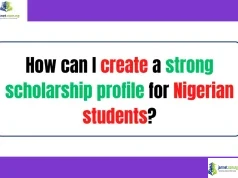This comprehensive guide will walk you through every step of the process on how to Write a Scholarship Essay That Wins, from brainstorming to polishing your final draft. We will then delve into the psychology of what scholarship committees are looking for, provide real life examples of winning essays, and give you the tools you need to craft a powerful and authentic narrative. By the end of this guide, you will have a clear roadmap to writing a scholarship essay that wins and a newfound confidence in your ability to tell your story.


Securing a scholarship is a transformative milestone for any student. It is the moment when academic financial burdens begin to lift, and the path to higher education becomes clearer. While grades and extracurricular activities are crucial, there is one element that can make or break your application, the scholarship essay. A well written essay is your voice, your story, and your chance to connect with the selection committee on a personal level.

Join our Telegram Channel for Updates
In a sea of qualified applicants, your essay is the single greatest opportunity to differentiate yourself. It is where you transition from a list of accomplishments on a resume to a compelling, 3 dimensional person with dreams, struggles, and a vision for the future.
The question is not how to write a scholarship essay that wins? It is “how do I write an essay that makes me unforgettable?”
Understanding the Why: The Purpose of a Scholarship Essay
Before you even start writing, it is essential to understand the purpose behind the scholarship essay. It is not a creative writing assignment or a book report. It is a strategic piece of marketing and you are the product.
What Committees Really Look For
Scholarship committees receive hundreds, if not thousands, of applications. They have seen countless 4.0 GPAs and lists of impressive extracurriculars. They know you are academically capable. What they don’t know is who you are. The essay is their window into your character, your motivations, and your potential.
Committees are looking for:
- Authenticity: They want to hear your unique voice, not a generic, perfectly worded essay that sounds like it was written by a robot.
- Resilience: They want to see how you have overcome challenges and what you have learned from them. Your struggles can be just as powerful as your successes.
- Passion: What drives you? What are you truly passionate about? Your essay should convey an unwavering commitment to your goals.
- Alignment with the Scholarship’s Mission: Does your personal story and future vision align with the values of the organization offering the scholarship? This is a key factor in their decision.
The Power of Your Personal Story
Think of your essay as a short story where you are the protagonist. Every great story has a beginning, a middle, and an end. It has a central conflict or challenge, a journey, and a resolution. Your personal story is an evidence of your growth and who you have become.
- What life experiences have shaped your perspective?
- What obstacles have you faced, and how did you overcome them?
- What is the single most important lesson you have learned?
These are the questions you need to answer. Your story is your most valuable asset, and a winning scholarship essay is a masterclass in telling it effectively.
The Pre-Writing Phase – Research and Strategy
Before you put a single word on the page, you need a plan. This is the most crucial part of the process and will save you countless hours of revision.
Understanding the Core Question
A common mistake students make is to read the question once and immediately start writing. Do not do this. Read the question multiple times. Break it down into its core components.
For example, a question might ask: Describe a time when you faced a significant challenge and what you learned from the experience.
Breakdown:
- Describe a time…: This requires a specific event, not a general summary.
- …faced a significant challenge…: The challenge must be meaningful and have a clear impact on you.
- …what you learned from the experience: This is the most important part. The committee is not only interested in the challenge; they are interested in your growth and self-awareness.
The Writing Phase – Crafting Your Narrative
Now that you have a solid plan, it is time to start writing. Remember, the goal is not perfection on the first draft. The goal is to get your ideas down and then refine them.
Hooking the Reader: The Art of a Captivating Introduction
The first sentence is your most important. You have seconds to capture the reader’s attention and make them want to continue reading. Avoid clichés like “I am writing to you today to apply for…” or “My passion for…”
Instead, start with:
- A vivid anecdote.
- A surprising statement or question.
- An engaging quotation that relates to your story.
Example of a weak introduction: I have always been passionate about science, and that is why I’m applying for this scholarship.
Example of a strong introduction: The strong smell of burnt plastic filled the air, a familiar aroma that marked both my biggest failure and my greatest lesson. At fourteen, my first attempt to build a functional circuit board fizzled and died, leaving me with a smoking mess and a deep sense of frustration. It was in that moment that I learned that true passion is about the resolve to pick up the pieces and try again.
The second example immediately pulls the reader into a specific moment of imagination, making them curious about what happened next.
Building the Body: Structure and Flow
The body paragraphs are where you develop your story and support your claims. Each paragraph should focus on a single idea and flow logically into the next.
- Paragraph 1: The Setup. Introduce the context of your story.
- Paragraph 2: The Conflict. Describe the challenge you faced.
- Paragraph 3: The Action. Explain what you did to overcome the challenge.
- Paragraph 4: The Impact. Discuss the results of your actions and, most importantly, what you learned.
Use transition words and phrases (Consequently, As a result, This experience taught me) to create a smooth, coherent narrative.
Show, Don’t Just Tell: The Power of Specificity
This is a golden rule for all good writing, and it is particularly critical for a winning scholarship essay. Instead of simply stating you are hardworking, show them with a specific example.
Telling: I am a hardworking student who is dedicated to my studies.
Showing: I spent countless nights in the library, poring over complex equations until the sun rose, not because I had to, but because I was driven by a genuine curiosity to understand the mechanics of the universe.
The second example paints a vivid picture and provides proof of your dedication without explicitly stating it. Use sensory details and specific actions to bring your story to life.
Crafting a Powerful Conclusion: Leaving a Lasting Impression
The conclusion is your final opportunity to leave an impression. It should do more than just summarize your essay. It should tie everything together and look toward the future.
- Reiterate your main lesson: Briefly restate the core lesson you learned.
- Connect to the future: Explain how this experience will impact your academic and career goals.
- Reaffirm your alignment with the scholarship: Explicitly state why you are a good fit for their scholarship and how you will use their support to achieve your goals.
End with a confident, forward looking statement that describes your potential.
Researching the Organization: Aligning with Their Values
Your essay should be a conversation with the organization, not a monologue. To have a conversation, you need to know who you are talking to. Visit their website. Read their About Us section. What is their mission? Who do they serve?
- If the scholarship is from a technology company, focus on how your skills and goals align with innovation and future technologies.
- If it is from a nonprofit dedicated to community service, your essay should highlight your volunteer work and how you plan to continue giving back.
Brainstorming Your Story: The Foundation of Your Essay
Once you understand the question and the organization, it is time to brainstorm. Do not pick the most dramatic story you have just to show off. Choose a story that allows you to showcase the qualities the committee is looking for.
Brainstorming techniques:
- Freewriting: For 10 minutes, write without stopping about a challenge you faced or a moment of personal growth. Do not worry about grammar or structure; just get your ideas down.
- Mind Mapping: Start with the core question in the center of a page. Branch out with different ideas, experiences, and people that relate to it.
- The “What, How, Why” Method:
- What happened? (The event)
- How did you respond? (Your actions)
- Why did it matter? (The lesson and impact)
This method ensures your story has a clear narrative arc and a strong takeaway, which is key to writing a scholarship essay that wins.
The Revision Phase – Polishing Your Work to Perfection
A first draft is never the final draft. Revision is where a good essay becomes a great one. This phase requires discipline and a critical eye.
The First Pass: Clarity and Cohesion
Read through your essay with a focus on the big picture.
- Does it answer the question completely?
- Is the narrative easy to follow?
- Is your thesis (the main point) clear throughout the essay?
- Are there any parts that feel weak or unfocused?
NOTE: Be ruthless. Cut out any sentences or paragraphs that don’t directly serve your narrative.
The Second Pass: Grammar, Spelling, and Punctuation
A single typo can make a bad impression. Use grammar checkers like Grammarly, but do not rely solely on them. Manually check for:
- Spelling errors.
- Punctuation mistakes (especially commas and apostrophes).
- Run on sentences and sentence fragments.
- Consistency in tense.
The Final Polish: Reading Your Essay Aloud
This is a simple but incredibly effective technique. Read your essay out loud. Your ears will catch awkward phrasing, choppy sentences, and confusing language that your eyes might miss. This final polish ensures that your essay has a natural rhythm and is a pleasure to read.
Real Life Scholarship Essay Examples (Winning Essays Analyzed)
To truly understand how to write a scholarship essay that wins, let us analyze a few successful examples.
Example 1: The Overcoming Obstacles Essay
Question: Describe a significant challenge you have faced and how it has shaped who you are today.
Analysis: The student begins with a vivid scene of his family’s small business struggling during the pandemic. He do not just say it was hard; He describe the empty storefront, the worrying conversations, and the feeling of helplessness. The essay then details the student’s proactive response: He took a free online course in digital marketing and created a new website and social media strategy for the business. The conclusion ties this experience to his future goals, explaining how it taught Him about resilience and creative problem solving, and how He plan to use his business degree to help other small businesses in the future.
Key Analysis: The student did not only tell a sad story. He focused on his actions and the lessons learned, showcasing his leadership and initiative skills.
Example 2: The Future Goals and Aspirations Essay
Question: Discuss your academic and career goals and how this scholarship will help you achieve them.
Analysis: The student starts with a powerful statement about his desire to become a civil engineer after witnessing the poor infrastructure in his hometown. He described a specific bridge that was consistently in disrepair and the dangers it posed to his community. He then seamlessly transition to his academic plan, mentioning specific courses he plan to take and professors he hope to work with. He conclude by explaining that the scholarship will allow him to focus on his studies without the need for a part-time job, thus maximizing his time and potential to make a difference.
Key Analysis: The essay is driven by a powerful why. It is not only about wanting to be an engineer; it is about a specific, personal motivation. The student also provides concrete details about his academic plan, showing they have a clear vision.
Example 3: The Community Service Essay
Question: How have you contributed to your community, and what did you learn from the experience?
Analysis: The student focuses on his experience volunteering at a local senior center. Instead of only listing his duties, he focus on a single, meaningful interaction with an elderly resident. He describes the resident’s story and how it changed his own perspective on aging and loneliness. The essay highlights the student’s empathy and their ability to connect with others. In the conclusion, he explain how this experience solidified his decision to pursue a career in occupational therapy, a field dedicated to helping people live more independent lives.
Key Analysis: The essay uses a single, powerful story to illustrate a broader point about empathy and personal growth, making it far more memorable than a general list of volunteer hours.
Actionable Tips from Scholarship Committee Members
We have broken down the process, but what do the people who actually read these essays have to say? We have compiled some key insights from these scholarship committee members.
Tip 1: Be Authentic and Vulnerable
The essays that stand out are the ones where students are not afraid to be a little vulnerable, says one committee member. Do not try to be who you think we want you to be. Be yourself. We want to see your personality shine through.
Tip 2: Stay Within the Word Count
This is a non negotiable rule. A student who can not follow a simple instruction like staying within the word count shows a lack of attention to detail. If the instruction says 500 words, write 500 words. Don’t go over.
Tip 3: Proofread, Proofread, Proofread
Nothing is more disappointing than reading a powerful essay with a dozen spelling and grammar errors. It shows a lack of effort. Get a friend, a teacher, or a parent to read your essay. A fresh pair of eyes can catch things you have missed a hundred times.
Finally, Writing a winning scholarship essay may seem like a daunting task, but when you break it down, it is really about one thing: telling your story effectively. Your grades, your test scores, and your accomplishments are important, but your story is what makes you human. It is what makes you memorable.
Remember, the scholarship committee is full of people who want to see you succeed. They are looking for a student they can believe in and invest in. Your essay is your chance to show them why that student is you. By following the steps in this guide, from the initial research to the final polish, you can craft a powerful, authentic, and unforgettable essay that will not only answer the question but will also leave a lasting impression. Your journey is unique, and it deserves to be told.













